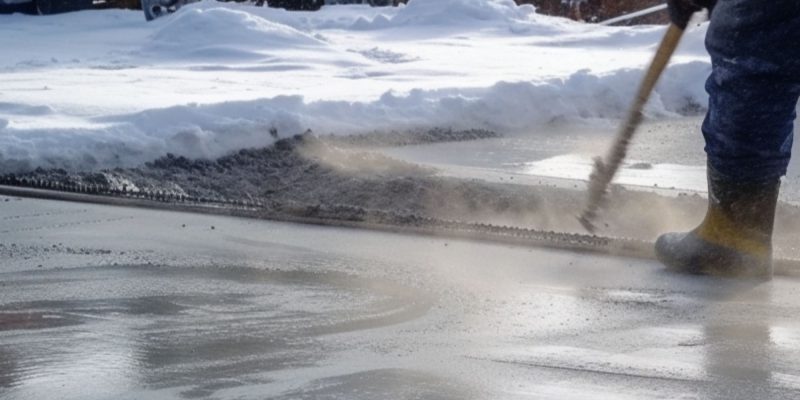Ever wondered if you can pour cement when it’s cold and frosty outside? Well, you’re not alone. Many folks think that cement work is off the table once winter hits until spring. But guess what? With the right know-how and some preparation, you can pour cement in winter. Let’s dive into how you can tackle this chilly challenge successfully.
Understanding Cold Weather Concreting
When the leaves fall and the temperature drops, many might think it’s time to put outdoor projects on hold. However, cold weather doesn’t mean you can’t pour cement; it just means you must approach it differently. Cold weather concreting is a specialized process designed to ensure that your cement pours are successful, even when Jack Frost is nipping at your nose.
What Makes Cold Weather Concreting Special?
In cold weather, the cement mixture can cool too quickly, hindering the hydration process that’s essential for the cement to set and gain strength. If the temperature drops too low, the water inside the cement can freeze, expanding and creating internal cracks that compromise the integrity and strength of the finished product.
Curing is the process where cement reaches its maximum strength…
Moreover, curing—the process where cement reaches its maximum strength—takes longer in cold weather. It’s a delicate balance: The cement must stay warm enough to cure without freezing but not so warm that it sets too quickly.
Why It’s Tricky?
- Freezing Risk: Cement has water; like any other water, it can freeze. Frozen cement doesn’t just pause the project; it can lead to weak structures that crack and crumble.
- Slow Curing: Cement loves warmth because it cures through a chemical reaction that’s more efficient at higher temperatures. When it’s cold, this process slows down, delaying project timelines and potentially affecting durability.
Planning is Key
Success in cold weather concreting starts long before the first cement truck arrives. It involves:
- Weather Watching: Keeping an eye on the forecast is crucial. Sudden temperature drops can spell disaster for an unprepared project.
- Material Readiness: Having all your materials ready and understanding how cold temperatures affect them can make or break your project.
- Strategic Scheduling: Plan your pour for the warmest part of the day and have a backup plan if the weather turns against you.
NOTE
Cold weather concreting is all about prevention and preparation. Understand the challenges and plan accordingly to ensure that your winter cement projects are just as successful as those in warmer months.
Ideal Temperature for Pouring Concrete in Cold Weather
Understanding the ideal temperature range for pouring concrete in cold weather is crucial for ensuring the longevity and durability of your project. While it might seem impossible, the proper knowledge and tools can make it achievable, even in the heart of an Iowa winter.
The American Concrete Institute (ACI) suggests that the ideal temperature for pouring concrete should be maintained above 40°F (4°C) for at least 48 hours after pouring. This range ensures that the chemical reactions necessary for curing can occur without the risk of freezing. However, it’s not just about the air temperature; the concrete mix, the ground, and any materials in contact with the concrete should also be kept above this critical temperature.
Why Temperature Management Matters
Temperature management is not just about preventing the concrete from freezing; it’s about ensuring the strength and integrity of the concrete. Proper temperature control helps to:
- Accelerate the hydration process, ensuring a stronger bond within the concrete.
- Reduce the risk of thermal cracking caused by too rapid cooling.
- Ensure a uniform and consistent cure throughout the concrete.
By understanding the ideal temperature conditions and employing strategies to maintain these conditions, you can pour concrete in winter with confidence, knowing that your project will stand the test of time.
Best Practices for Pouring Concrete in Cold Weather
Pouring concrete in the chill of winter requires a blend of careful planning, the right materials, and specific techniques to ensure the job is done right. Here’s how to navigate the cold to achieve a successful concrete pour.
Choose the Right Concrete Mix
Selecting a concrete mix that’s designed for cold weather is the first step. These mixes often contain accelerators that reduce the time it takes for the concrete to set, minimizing exposure to harmful cold temperatures. Additionally, consider the slump (or fluidity) of your concrete; a mix that’s too wet can increase the risk of freezing.
Preparing the Site
Preparation is key to any successful concrete project, especially in winter. Clear any snow, ice, or water from the pour site. Pre-warming the ground using heated blankets or a temporary heat source can prevent the cold earth from sapping heat away from your concrete.
Use Warm Water and Additives
Mixing your concrete with warm water helps keep the temperature of the concrete mix within an ideal range during the pour. Additives, like calcium chloride, can also be used to accelerate the curing process, but be sure to follow manufacturer recommendations to avoid compromising the concrete’s strength.
Keep It Covered
After pouring, insulating blankets or plastic sheeting should be used to retain heat within the concrete. These coverings help maintain the temperature and protect the surface from freezing rain or snow.
Monitoring Temperature
Using a concrete thermometer to monitor the temperature of the mix before, during, and after pouring is essential. This ensures the concrete remains above the critical freezing point and allows for adjustments in real time to maintain ideal curing conditions.
Employing Windbreaks and Enclosures
In windy conditions, using windbreaks can prevent the rapid cooling of concrete. For larger projects or particularly harsh conditions, temporary enclosures heated by propane heaters can create a controlled environment conducive to curing.
Curing Considerations
Proper curing is crucial for strength development in concrete. This may mean extending the curing period in cold weather to ensure the concrete achieves its desired properties. Wet curing methods, often ideal in warmer temperatures, should be avoided in freezing conditions unless the area is adequately heated.
Quality Control Measures
Throughout the process, maintaining a strict regimen of quality control checks is vital. This includes testing the concrete for temperature, slump, and air content before pouring and continuing to monitor and protect the concrete during the critical first hours and days of curing.
Tips for Success in Cold Weather Concreting
Tackling a concrete project during the cold months in Des Moines, Iowa, doesn’t have to be daunting. With the right approach, you can ensure your winter concreting success. Here are some additional tips to help you along the way:
Plan for Extra Time and Resources
Winter concreting often requires more time and resources than the same project might need in warmer weather. Plan for this by allocating extra days in your project timeline for weather-related delays and ensuring you have access to additional materials and equipment, such as heating blankets or enclosures, if needed.
Keep a Close Eye on the Weather
Weather can be unpredictable, especially in winter. Keep a close eye on the forecast and be prepared to adjust your plans accordingly. This might mean choosing a different day for your pour or having strategies ready to protect your concrete from unexpected cold snaps.
Ensure Adequate Heating
If you’re using supplemental heating to protect your concrete or warm-up components before mixing, ensure it’s adequate for the task. This means utilizing enough heating blankets, ensuring temporary enclosures are sufficiently heated, and verifying that any heated water or aggregates are at the right temperature before use.
Use the Right Concrete Mix
Choosing a concrete mix that’s suited for cold weather, with the right type of accelerators and admixtures, can make a significant difference. Don’t hesitate to consult with suppliers about the best products for your specific conditions and project requirements.
Protect the Surface from Early Exposure
Once poured, the concrete’s surface is vulnerable to freezing before the rest of the mix. Protecting this surface with insulating blankets or a layer of straw covered by plastic sheeting can prevent surface damage that compromises the concrete’s integrity.
Monitor Concrete Temperature Regularly
Invest in a good quality concrete thermometer and regularly check the temperature of your mix before pouring and during curing. This will help you ensure that the concrete stays within the ideal temperature range for curing.
Be Prepared for Emergencies
Have a plan in place for what to do if the weather takes a turn for the worse or if your concrete starts to cool too quickly. This might include having extra insulating materials on hand or a backup heating source ready to deploy.
Practice Patience
Finally, remember that concrete poured in cold weather might take longer to reach its full strength. Practice patience, and resist the temptation to rush the process. Giving your concrete the time it needs to properly cure will pay off in the long run with a stronger, more durable finish.
Conclusion
Can you pour cement in winter? Absolutely! With strategic planning, the right materials, and effective techniques, overcoming the challenges of cold weather is feasible. Armed with ACI recommendations and a solid understanding of winter concreting, you can ensure successful and durable projects, proving that cold months offer fruitful opportunities for concrete work.
Frequently Asked Questions
What temperature is too cold for cement?
The temperature considered too cold for cement is below 40°F (4°C). At or below this threshold, the hydration process that strengthens cement can slow significantly or even halt, leading to potential freezing of the water within the mix. This can cause damage and weaken the final structure. For optimal curing and strength development, maintaining a temperature above 40°F during and after pouring is crucial.
Can you pour a concrete foundation in the winter?
Yes, you can pour a concrete foundation in the winter, provided that certain precautions are taken to protect the concrete from freezing temperatures. This involves using heated enclosures, warm water in the mix, and additives that accelerate curing. It’s essential to maintain the concrete at an appropriate temperature to ensure it sets correctly and achieves the required strength. Adhering to cold weather concreting practices can make winter foundation projects successful.
How long can you pour cement in winter?
You can pour cement in winter as long as the necessary measures to prevent the mix from freezing are in place and the temperature of the concrete is maintained above 40°F for at least the first 48 hours after pouring. The use of warm mixing water, insulating blankets, and additives that help the concrete set faster can extend the window for winter concreting. Proper planning and monitoring allow for successful cement pouring throughout the colder months.

